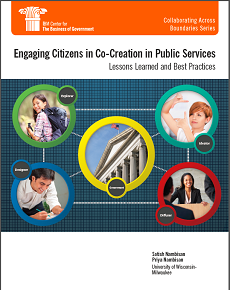
Four Roles for Citizen Co-Creators

A new report presents an innovative framework from which to view citizen “co-creation” of government services. The IBM Center for the Business of Government has released “Engaging Citizens in Co-Creation in Public Services Engaging Citizens in Co-Creation in Public Services,” which continues to explore the of public service co-creation and co-delivery, following the Center report, Beyond Citizen Engagement: Involving the Public in Co-Delivering Government Services, published in 2013. Taken together, these two reports are on the forefront of increased insight into how governments can improve services through co-creation and co-delivery.
The term “co-creation” refers to the development of new public services by citizens in partnership with governments. The authors present four roles that citizens co-creators often assume: explorer, ideator, designer, and diffuser.
- Explorers identify/discover and define emerging and existing problems.
- Ideators conceptualize novel solutions to well-defined problems.
- Designers design and/or develop implementable solutions to well-defined problems.
- Diffusers directly support or facilitate the adoption and diffusion of public service innovations and solutions among well-defined target populations.
Report authors Drs. Satish and Priya Nambisan of University of Wisconsin-Milwaukee provide detailed examples of citizens playing each of these roles. They note that numerous forces contribute to the trend of citizens participating in government activities, “a shift from that of a passive service beneficiary to that of an active, informed partner or co-creator in public service innovation and problem-solving.“
The help government leaders craft successful co-creation programs, the report outlines four strategies to encourage citizen co-creation:
- Fit the approach to the innovation context
- Manage citizen expectations
- Link the internal organization with the external partners
- Embed citizen engagement in the broader context
The IBM Center has sponsored a series of reports that address specific approaches to co-creation and co-delivery. Two (Challenge. gov: Using Competition and Awards to Spur Innovation and Managing Innovation Prizes in Government) address how the federal government is using competitions to engage citizens in the development of new ideas and new products. A third, Federal Ideation Programs: Challenges and Best Practices, discusses how the federal government can tap creative thinking from across the citizenry to come up with new approaches to solving problems. A fourth report, Using Crowdsourcing in Government, discusses how the federal government can leverage groups to build ideas into actionable strategy through increased citizen engagement.
Collectively, these reports are building a new body of knowledge on how government leaders can engage citizens in new ways, allowing them to participate more actively in the design and delivery of public services. We hope this report will assist all public managers as they continue their quest for innovative ideas.



